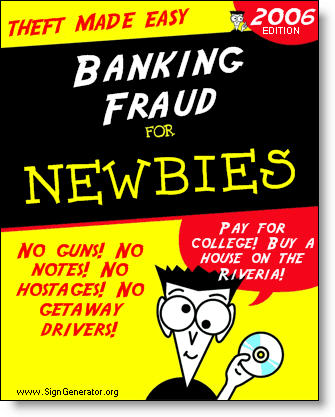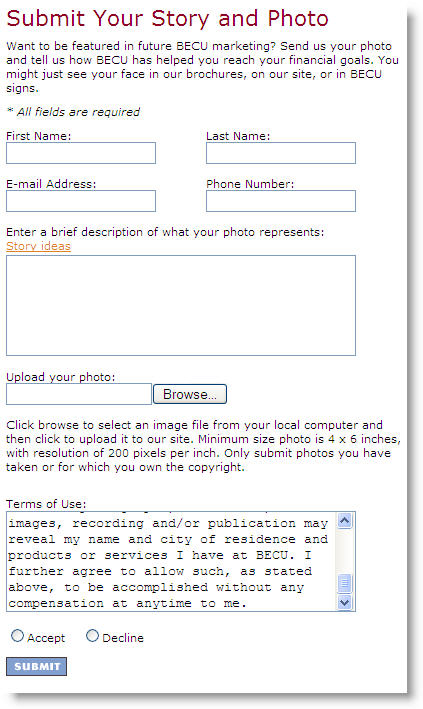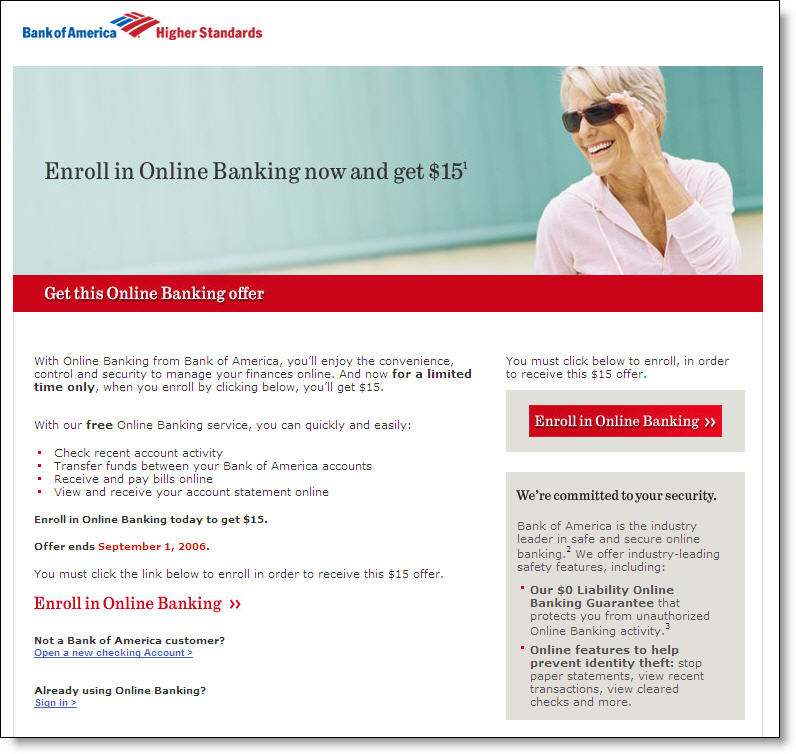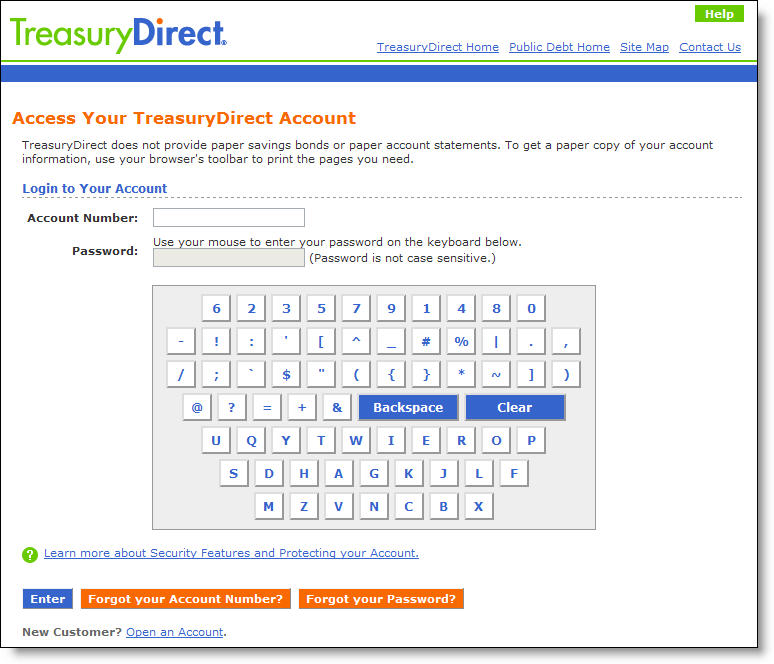There's much to choose from this fall, click on the link below to see the complete calendar of events of interest to online banking and financial services marketing professionals.
Author: Jim Bruene
HSBC Teams with Marriott to Give New Customers Free Lodging
 HSBC <us.hsbc.com> is offering new Smart Idea checking customers a free night at participating Marriott hotels, and are even tossing in breakfast for two. The only major requirement, as outlined in the relatively scant fine print (click on continuation link at the bottom of this article), is a direct-deposit relationship or $3,000 deposited by the end of September. The screenshot right shows the offer on the bank's homepage (click to enlarge).
HSBC <us.hsbc.com> is offering new Smart Idea checking customers a free night at participating Marriott hotels, and are even tossing in breakfast for two. The only major requirement, as outlined in the relatively scant fine print (click on continuation link at the bottom of this article), is a direct-deposit relationship or $3,000 deposited by the end of September. The screenshot right shows the offer on the bank's homepage (click to enlarge).
Here's the landing page for the offer (first click off the homepage):
Analysis
This is a good offer because the perceived value of $200+ is likely far less than what HSBC is paying for it, which we estimate is considerably less than $100 due to the exposure Marriott receives. While it may not appeal to the stay-at-home crowd, they are not the target market for HSBC's premium checking account.
We also like the alternative to dropping $3 grand in the account in lieu of direct deposit. That appeals to small business owners and the self-employed who often are ineligible to participate in many bank premium offers that require direct deposit. However, the bank should work with the single-deposit customers to get some electronic hooks into the account as soon as possible, either electronic bill payments, pre-authorized debits, or an integrated credit line with automatic payments from checking.
—JB
Notes:
Fine print for HSBC's offer:
* Minimum balance to avoid monthly maintenance fee applies if direct deposit ceases. To receive the Marriott award, customers must open an Interest Checking account by 9/30/06 and either set up direct deposit or deposit at least $3,000 by 10/31/06. Interest Checking Account has 0.15% Annual Percentage Yield (APY), which is accurate as of 8/1/06 on balances of $5 or more. APY is variable and subject to change after opening. Charges and fees may reduce earnings. HSBC reserves the right to charge your Interest Checking account an amount equal to the bonus if your account does not remain active for at least 180 days. Hotel redemption forms will be sent to qualifying customers by 12/31/06. Hotel award includes accommodations for a one (1) night stay, including breakfast for two and room tax, at participating Marriott properties in North, South and Central America, Hawaii and the Caribbean, subject to availability. Breakfast not included at SpringHill Suites and TownePlace Suites properties. Hotel reservations must be booked and used by 1/1/08. Limit of one hotel award per customer. Cost of gift will be reported on IRS Form 1099.
** The Introductory APR does not apply to cash advances. After the Introductory Period or if during the first 12 billing cycles of your Account, whichever is earlier, your Minimum Payment (or any greater amount) is late or you exceed your credit limit twice, the Introductory APR will increase to the Customary APR. The variable Customary APR is 11.99%, 15.99% or 18.99% (as of 8/1/06), depending upon your creditworthiness. There is no balance transfer fee for balance transfers that post to your Account within 90 days of your Account opening; otherwise a 3% ($5 minimum, $50 maximum) balance transfer fee will apply, unless otherwise disclosed. We apply payments to lower APR balances before higher APR balances. We have the right to change your APRs, fees, and other terms at any time, for any reason including, but not limited to, any change in your credit history, credit obligations, Account performance, use of your credit lines with us or any creditor, or our financial return. Any changes will be in accordance with your Cardmember Agreement and applicable law.
US Bank Introduces Email Alerts 2.0
Friday, US Bank <usbank.com> began using a new design for its email alerts. It has a softer, more modern look to it (see before and after screenshots below). The layout and copy are identical to the previous version.
The new look arrived about the time we intended to post a rant about the lack of creativity in bank messaging. One of our examples was US Bank, which had sent us the same basic confirmation message more than 1,000 times over the past three years.
While it's good to see an improved design, it's still pertinent to note that there is more to the lack-of-creativity argument than just the font and background colors. The problem with email alerts is that after receiving them two or three times per week for several years, many users may ignore them. To keep that from happening, financial institutions need to upgrade their messaging system; let's call it Alerts 2.0.
Here are some important features of Alerts 2.0 (for a detailed look at bank messaging, see Online Banking Report #91/92) :
- Educate about preference changes: Once or twice per year, perhaps more frequently for those receiving a large number of alerts, remind customers about the types of alerts available and how to change them.
- Provide periodic summaries: Someone getting six alerts each week would likely appreciate a weekly summary of all changes.
- Change the "look & feel" periodically: Don't wait three years to change the design. Create a template so that the alert design can easily be changed to fit the season or holiday.
- Gently cross-sell: Alerts should be kept primarily factual. But every once in a while, most of your customers would appreciate a low-key "reminder" of relevant services, such as overdraft protection, credit report monitoring, and so on.
- Give thanks: As trite as it sounds, don't forget to thank the customer, at least every once in a while. For example, you might add a thank-you when receiving a large deposit (or ANY deposit for that matter). Also, a periodic "thanks for participating in online banking" and/or email alerts would be appropriate. This would also be a good time to ask for feedback on the service.
US Bank email alerts redesign (click on images to enlarge):
New  Old
Old 
–JB
Bank Branding – What’s in aName?
Two data points:
- A front-page story in today's Seattle Times reveals Washington Mutual's d
 ecision to change their brand name to WaMu.
ecision to change their brand name to WaMu. - Monday's American Banker told of Alhambra, CA-based InterBusiness Bank name change to Tomato Bank.
Two name changes among 8,000 U.S. banks is hardly a trend. But as the Internet becomes more and more important to your new account acquisition (see Online Banking Report 128, "The Demise of the Branch"), you must consider how your name works online. First National Bank and Trust looks good on a main-street signpost, but when translated to cyberspace it loses much, if not all, of its appeal. The problems?
- Not memorable: Too many generic words strung together make a name difficult to recall when potential customers return to their computers.
- Not searchable: Again, too many generic words makes it hard to even find in a search engine.
- No domain name available: The domain names containing first, national, and bank have long been snatched up by early adopters in 1995 and 1996. Many banks have had to resort to hard-to-remember domains such as <ibankfnb.com> from First National Bank of Hudson.
- Not a modern brand: While it's nice to have your name create a feeling of trust and security, generic names reinforce the impression that the bank is not modern and technologically savvy, not good positioning for attracting customers online.
A name change is one of the biggest decisions a company will make, so we won't presume to give you advice on that point. However, you must consider the effectiveness of your brand online, both in recall, search, and overall company image.
—JB
Web-Based Calendar Company for Sale
 In Online Banking Report, we've looked at online calendars as nice-to-have additions to banking websites. They fulfill a personal financial-management role by tracking and sending reminders of bill payment and other deadlines.
In Online Banking Report, we've looked at online calendars as nice-to-have additions to banking websites. They fulfill a personal financial-management role by tracking and sending reminders of bill payment and other deadlines.
If you are interested in adding a calendar to your user interface, there is a unique opportunity to purchase a turn-key calendar website, that provides not only the code, done in a Web 2.0-like look, but also 40,000 monthly visitors. You could potentially pick up some customers from the existing user base as well.
The site, Kiko.com, is for sale in an eBay auction that ends on Aug. 26. Opening bid = $50,000.
Thanks to TechCrunch for the tip.
Washington Mutual Joins High-Rate Savings Game
Reports first surfaced Saturday (Aug. 12) that Washington Mutual was offering 4.75% on a no-minimum deposit savings account. But don't try to find it on their website. The offer is only visible after you begin the application process for one of the highly promoted free checking accounts (see NB July 20).
We searched the WAMU website using a variety of states and did not see any mention of the high rate. However, the bank could be using cookies or other methods to serve the banners to select customers (see Citibank, NB May 10). In our tests (from a Seattle IP address), users are first introduced to the savings offer on the first page of the online checking account application (click on screenshot below for a closeup).
Like Citibank's e-Savings Account, Washington Mutual is requiring a checking account to take advantage of the offer. However, WAMU's checking account is completely fee-free regardless of balance and with no direct-deposit requirement. Current WAMU customers can take advantage of the high rate, which is 12 times higher than the current 0.4% rate, only by opening a new checking account.
Analysis
WAMU is attempting to minimize deposit cannibalization by keeping the offer off the website. They are attempting to leverage their free checking campaign by upselling new customers at the point of sale. For a bank with a major branch presence, that's not a bad approach; however, it's not going to bring in deposits at the same rate as Citi or HSBC.
It will also be interesting to see how the bank deals with the inherent channel conflicts. If the high-rate deposits are credited to the Internet channel only, branches will be up in arms over the 12x rate advantage offered online. But if branches do get credit for the deposits, they will be converting their biggest customers into the new accounts as fast as possible (unless WAMU rewards branches by account profitability).
FFIEC Releases FAQ on Enhanced Security Requirements
 Today, the Federal Financial Institutions Examination Council (FFIEC) issued a 7-page list of questions and answers about its October 12, 2005, bestseller, Authentication in an Internet Banking Environment.
Today, the Federal Financial Institutions Examination Council (FFIEC) issued a 7-page list of questions and answers about its October 12, 2005, bestseller, Authentication in an Internet Banking Environment.
 The main thing you need to know about the new document is what it does NOT say, that the year-end deadline has been extended (see Timing, Q1, p. 4, reprinted below). However, the answer does appear to provide a bit of wiggle room, saying that banks must "implement risk mitigation activities by year-end 2006." I'm sure many creative interpretations of the precise meaning of that phrase will surface.
The main thing you need to know about the new document is what it does NOT say, that the year-end deadline has been extended (see Timing, Q1, p. 4, reprinted below). However, the answer does appear to provide a bit of wiggle room, saying that banks must "implement risk mitigation activities by year-end 2006." I'm sure many creative interpretations of the precise meaning of that phrase will surface.
Q-1- What do the Agencies expect institutions to have accomplished by year-end 2006?
A-1– The Agencies expect that institutions will complete the risk assessment and will implement risk-mitigation activities by year-end 2006. The Agencies are not considering any general extension of the timing associated with this guidance.
Good luck to all.
—JB
Financial Keyword Frequency from AOL Search Data
![]() The privacy furor that erupted August 6 over the 20-million Web queries posted by AOL has distracted from the useful information contained in the database. While AOL removed it a week ago, numerous search-engine researchers had already downloaded the file and have reposted it with front-ends for research purposes.
The privacy furor that erupted August 6 over the 20-million Web queries posted by AOL has distracted from the useful information contained in the database. While AOL removed it a week ago, numerous search-engine researchers had already downloaded the file and have reposted it with front-ends for research purposes.
SEO Sleuth <seosleuth.com> has posted the top-2000 search terms from the AOL sample. Click the continuation link below to see a list of all banking terms that made the top 2000 list. Here's the first 10 with their overall rank among all search terms:
40. bank of america
86. bankofamerica
114. fidelity
159. bankofamerica.com
170. paypal
174. www.bankofamerica.com
202. free credit report
215. american express
259. wachovia
264. wells fargo
What's striking about the AOL search data is the overwhelming preference to search on brand names rather than product categories. Also, that Bank of America has an extraordinary share of mind with searchers, with its various forms accounting for four of the top six most-searched financial services terms.
—JB
Rank/Search Term/Number of Searches/% of Searches that Ended in a Click (to ANY website)
Note: Click on the search term for a list of the websites visited after entering this search term
| 40 | bank of america | 5,920 | 70% |
| 86 | bankofamerica | 3,450 | 71% |
| 114 | fidelity.com | 2,862 | 77% |
| 159 | bankofamerica.com | 2,280 | 53% |
| 170 | paypal | 2,197 | 24% |
| 174 | www.bankofamerica.com | 2,174 | 45% |
| 202 | free credit report | 2,007 | 61% |
| 215 | american express | 1,931 | 70% |
| 259 | wachovia | 1,715 | 68% |
| 264 | wells fargo | 1,691 | 76% |
| 283 | capital one | 1,620 | 44% |
| 284 | zillow.com | 1,616 | 36% |
| 313 | chase.com | 1,525 | 57% |
| 327 | wellsfargo.com | 1,460 | 50% |
| 333 | chase | 1,454 | 64% |
| 343 | mortgage calculator | 1,420 | 62% |
| 382 | www.capitalone.com | 1,290 | 18% |
| 391 | washington mutual | 1,266 | 78% |
| 448 | citibank | 1,155 | 79% |
| 457 | wachovia.com | 1,135 | 52% |
| 488 | www.wellsfargo.com | 1,089 | 47% |
| 509 | capitalone.com | 1,041 | 24% |
| 525 | wellsfargo | 1,017 | 62% |
| 528 | credit report | 1,014 | 62% |
| 555 | capitalone | 985 | 41% |
| 558 | wamu.com | 983 | 67% |
| 667 | checks | 850 | 75% |
| 674 | chase bank | 846 | 72% |
| 689 | credit cards | 835 | 42% |
| 708 | www.bankofamerica | 817 | 20% |
| 731 | mbna | 795 | 78% |
| 732 | bank of america.com | 795 | 54% |
| 756 | personal loans | 775 | 78% |
| 782 | www.wachovia.com | 761 | 39% |
| 807 | paypal.com | 745 | 19% |
| 813 | zillow | 739 | 50% |
| 819 | commerce bank | 735 | 83% |
| 901 | wamu | 685 | 71% |
| 910 | freecreditreport.com | 682 | 34% |
| 922 | fidelity | 675 | 70% |
| 961 | usbank | 656 | 77% |
| 984 | loans | 644 | 33% |
| 985 | providian | 644 | 86% |
| 1058 | mypay | 612 | 90% |
| 1085 | hsbc | 601 | 51% |
| 1145 | usaa | 570 | 75% |
| 1171 | americanexpress.com | 563 | 53% |
| 1195 | us bank | 553 | 80% |
| 1232 | ameritrade | 541 | 60% |
| 1249 | discover card | 536 | 65% |
| 1251 | etrade | 535 | 65% |
| 1309 | auto insurance | 518 | 51% |
| 1319 | aetna | 516 | 78% |
| 1333 | www.wamu.com | 512 | 71% |
| 1371 | www.zillow.com | 501 | 25% |
| 1388 | usbank.com | 496 | 63% |
| 1396 | orchard bank | 493 | 50% |
| 1425 | wells fargo bank | 484 | 75% |
| 1446 | payday loans | 479 | 72% |
| 1449 | citizens bank | 478 | 74% |
| 1488 | bank one | 469 | 73% |
| 1494 | suntrust | 467 | 82% |
| 1502 | wwwbankofamerica.com | 464 | 21% |
| 1529 | www.providian.com | 458 | 76% |
| 1548 | www.citicards.com | 452 | 35% |
| 1582 | wachovia bank | 444 | 52% |
| 1630 | experian | 435 | 57% |
| 1648 | americanexpress | 431 | 59% |
| 1655 | www.bank of america.com | 430 | 44% |
| 1663 | national city bank | 427 | 77% |
| 1693 | www.chase.com creditcards | 420 | 52% |
| 1714 | bad credit loans | 416 | 80 |
| 1715 | providian.com | 416 | 79% |
| 1801 | credit reports | 403 | 63% |
| 1823 | usaa.com | 400 | 62% |
| 1833 | citicards.com | 397 | 48% |
| 1873 | www.americanexpress.com | 392 | 38% |
| 1879 | american express.com | 391 | 30% |
| 1883 | annualcreditreport.com | 391 | 62% |
| 1912 | bankone | 386 | 75% |
| 1927 | life insurance | 385 | 60% |
| 1964 | zillo.com | 380 | 17% |
| 1978 | countrywide | 376 | 50% |
Boeing Employees Credit Union Posts User-Generated Content
Playing into the summertime digital photo frenzy, Boeing Employees Credit Union <becu.org> is asking members to send a photo and short story for posting on the Seattle-based CU's homepage <becu.org> (see below for an example).
Photographs can be uploaded through the website, emailed in, or for those not into digital photography, a 4×6 or larger print can be mailed in. Either way, every person in the photograph must sign a release, also available on the website.
Here's how it looks on the homepage (click for larger version):
Click on the continuation link below to see the landing page for the promotion and the upload form.
—JB
Notes:
The landing page (accessible through link from lower portion of homepage, see above):
Here's the uploading form:
Bank of America Pays $15 to Enroll in Online Banking
 What's better than free online banking and bill payment? Getting paid 15 bucks to sign up. In a late summer effort to bump up the size of what is already the world's largest online banking program, Bank of America is paying non-users $15 to sign up for online banking. And it's not a subtle statement-stuffer program: the large banner dominates the bank's homepage today (click on inset for a closer look and see the landing page below).
What's better than free online banking and bill payment? Getting paid 15 bucks to sign up. In a late summer effort to bump up the size of what is already the world's largest online banking program, Bank of America is paying non-users $15 to sign up for online banking. And it's not a subtle statement-stuffer program: the large banner dominates the bank's homepage today (click on inset for a closer look and see the landing page below).
BofA checking customers must merely complete the online sign-up application before Sept. 1 to receive an extra $15 in their accounts before Thanksgiving. They aren't even required to use the service after the initial signup.
Analysis
First, why Bank of America, already synonymous with FREE online banking, would pay to get more users is beyond me, but I'm sure they have research to back up this move. And even if you agree it is worth paying for enrollment, $15 seems like too much. Why not $10 or even $5? If the bank is just trying to nudge fence-sitters into online banking, it doesn't seem like the dollar amount needs to be very high. Even a sweepstakes might do the same thing.
TreasuryDirect adds Virtual Keyboard
A number of banks, including ING Direct <ingdirect.com> and ABSA <absa.co.za> have added virtual keypads to defeat keyloggers, but the U.S. Treasury Department's Treasury Direct <treasurydirect.org> website is the first time we've seen an entire virtual keyboard. The layout is scrambled after each login, an extremely non-user-friendly feature.
The Treasury may have added a bit more security than is necessary, especially in light of Aite Group's <aitegroup.com> latest research that online banking fraud in the United States was a scant $4 million last year (correct, that is no typo, it's MILLION as in 4 cents per U.S. household). The virtual keyboard itself would defeat most hacks; there's no need to scramble it every time.
Thanks to MyMoneyBlog for the tip. Interestingly, most of the 16 comments on the new security feature were negative because of the extra hassle.
Foonance Launches Web-based Expense Tracker
![]() Foonance <foonance.com> is an online personal finance program with a Web 2.0 design. The free service is similar to Moneytrackin' (NB Aug. 9), but with a much simpler URL and a more interesting design.
Foonance <foonance.com> is an online personal finance program with a Web 2.0 design. The free service is similar to Moneytrackin' (NB Aug. 9), but with a much simpler URL and a more interesting design.
 Users create "Money Stores" anywhere that cash is stored, and then add "in" or "out" transactions to track balances. Each transaction is tagged with multiple descriptors and a "tag cloud" can be used to access running balances in each category.
Users create "Money Stores" anywhere that cash is stored, and then add "in" or "out" transactions to track balances. Each transaction is tagged with multiple descriptors and a "tag cloud" can be used to access running balances in each category.
 The company promises new features every two weeks, an unusual pledge. I'm not sure the average user wants that much excitement in their personal finance app, but it does have an appeal to the ultra-early adopter who'd be likely to give Foonance a try.
The company promises new features every two weeks, an unusual pledge. I'm not sure the average user wants that much excitement in their personal finance app, but it does have an appeal to the ultra-early adopter who'd be likely to give Foonance a try.
Banks looking to add personal finance functionality to their offering should take a look at how Foonance accomplishes relatively simple functions with panache.
—JB







